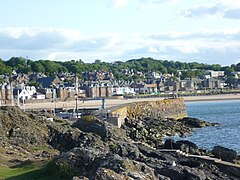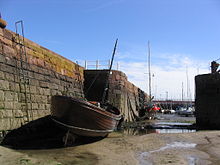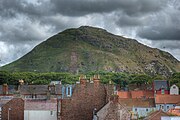North Berwick
North Berwick
| |
|---|---|
 West Bay from the harbour | |
 North Berwick North Berwick shown within East Lothian | |
| Population | 6,605 |
| OS grid reference | NT553852 |
| Civil parish |
|
| Council area |
|
| Lieutenancy area |
|
| Country | Scotland |
| Sovereign state | United Kingdom |
| Post town | North Berwick |
| Postcode district | EH39 |
| Dialling code | 01620 |
| Police | Scottish |
| Fire | Scottish |
| Ambulance | Scottish |
| EU Parliament | Scotland |
| UK Parliament |
|
| Scottish Parliament |
|
North Berwick (/ˈbɛrɪk/; Scottish Gaelic: Bearaig a Tuath)[1] is a seaside town and former royal burgh in East Lothian, Scotland. It is situated on the south shore of the Firth of Forth, approximately 25 miles (40 km) South-East of Edinburgh. North Berwick became a fashionable holiday resort in the nineteenth century because of its two sandy bays, the East (or Milsey) Bay and the West Bay, and continues to attract holidaymakers. Golf courses at the ends of each bay are open to visitors.
Contents
1 History
2 Islands
3 Attractions
4 Transport
5 Literary links
6 Notable people
7 Twin town
8 See also
9 References
10 External links
History

North Berwick East Bay
The name North Berwick means North "barley farmstead" ("bere" in Old English means "barley" and "wic" in Old English is 'farmstead'). The word North was applied to distinguish this Berwick from Berwick-upon-Tweed, which throughout the Middle Ages the Scots called South Berwick. It was recorded as Northberwyk in 1250. On the south of North Berwick Law there is evidence of at least eighteen hut circles, rich middens and a field system dating from 2,000 years ago.

A view east towards the town centre

The same view in winter
Excavations have shown that from as early as the eighth century, a ferry crossing to Earlsferry, near Elie in Fife was in existence, serving pilgrims on their way to the shrine of Saint Andrew.[2]North Berwick Harbour was built in the twelfth century to meet the demands made of the existing ferry trade. This ferry was recently reinstated; during the summer, a boat travels between North Berwick and Anstruther in Fife, in homage to the original ferry.
Around 1150, Duncan, Earl of Fife of the Clan MacDuff[3] founded an influential Cistercian nunnery (whose power continued until the Scottish Reformation, and its dissolution in 1588). Duncan's family shortly afterwards, at the start of the thirteenth century built North Berwick Castle[4] erecting a wooden motte and bailey on the site of what is now Castle Hill in the East end of the town at the start of Tantallon Terrace. This castle was attacked and held by the Earl of Pembroke around 1306; the English abandoned it by 1314, during the aftermath of the Battle of Bannockburn. In the late-fourteenth century, the Lauder family (owners of the Bass Rock castle) erected a stone tower with a barmkin on the site; however they abandoned it by 1420 in favour of the Bass, possibly as a result of conflict with the then owners of nearby Tantallon Castle.
In the fourteenth century, the town became a baronial burgh under William Douglas, 1st Earl of Douglas, who then built nearby Tantallon Castle to consolidate his power.
Later during the fifteenth century, the town became a royal burgh in the reign of James I of Scotland.
The "Auld Kirk Green" at the harbour was used for gatherings by the accused in the North Berwick Witch Trials (1590–92). Legend has it that "Satan himself" attended a ritual there in 1590, although it is more likely that Satan was "played" by Francis Stewart Hepburn, 5th Earl of Bothwell. During the sixteenth century, at least seventy people were implicated in the Witch Trials, and the events inspired works such as Burns' "Tam o' Shanter" and "The Thirteenth Member" by Mollie Hunter. One of the most famous Witch Trials at North Berwick: was of a woman named Agnes Sampson. She was accused of making a potion to make the storms rough as King James VI of Scotland was sailing home from Denmark with his new wife, Anne of Denmark. The trial took place in 1591, and King James himself, was present. Sampson was tortured to confess and then burned at the stake, like many other innocent people.

Harbour at low tide
Whaling in the eighteenth century. Local lore, place names, and the jawbone arch atop the Law erected in 1709,[5] suggest that the port was involved in the whaling industry though there is little written evidence left to prove it. In any event it would have been overshadowed by nearby Leith.[6] Certainly whales have been known to have washed ashore here; regularly over the years, even in recent times.[7]
Despite the railway arriving in 1850, the Industrial Revolution bypassed the town. The late-nineteenth century saw North Berwick develop golfing and holiday facilities. The town soon became popular as a home for Edinburgh commuters and retirees.
The size and population of the town remained fairly steady until the 1970s, at which point housebuilding began in earnest around the periphery of the town, first to the south (1950s–70s), then a series of major expansions to the west (1980s-present) along the line of the railway. There is talk of further developments focussing on "affordable housing" on the south side of the town. While the population might not have truly "exploded", house prices have. North Berwick consistently appears at the top of national house price surveys, and like-for-like prices are comparable to Edinburgh. North Berwick was listed as the most expensive seaside town in Scotland in 2006, and was second to St. Andrews in 2009.[8][9]
Islands

Harbour and Craigleith
Several of the Islands of the Forth are near the town and visible from it: e.g. Fidra, The Lamb, Craigleith, and Bass Rock; the latter hosts a thriving colony of birds, including puffins, gannets, and other seabirds. The Bass Rock appears white, but this is due largely to the gannets and their guano that cover much of its surface. The seabirds themselves can be observed at close range through remote cameras operated from the recently developed Scottish Seabird Centre near the harbour.
Attractions

A "spring" tide, West Bay

West Bay front North Berwick
- Boat trips to the Bass Rock, Fidra and other islands.
Scottish Seabird Centre – Visitor centre about seabirds found on Bass Rock and elsewhere.
North Berwick Law – A 613-foot (187 m) volcanic hill which rises above the town, with a Napoleonic era signal station. The whale's jawbone "arch" at the summit collapsed in June 2005, and was eventually replaced by a fibreglass replica in June 2008.
North Berwick Law seen from the seafront of North Berwick- Beaches – One of North Berwick's main attractions, the beaches have golden sands and rocks, and a tide-filled boating pond/paddling pool on the East Sands.
Seacliff. Just to the east of the town, an entry fee is charged at this private and largely unspoilt beach and estate.- Golf – There are two golf courses in the town, the West Links and the Glen, or East Links, and numerous others in the surrounding area. There are also two 18-hole putting greens and a Golfing Heritage Trail to follow through the town.
- Tennis – Venue for the annual East Lothian Open Tennis Tournament.
- The East Lothian Yacht Club hosts many national and international sailing events.
- The John Muir Way, the East Lothian coastal path, passes through the town.
Tantallon Castle, a mostly ruined 14th-century fortress in the care of Historic Scotland, is 3 miles (5 km) east of North Berwick.
Transport
The town is served by North Berwick railway station. The North Berwick Line has provided a rail link with Edinburgh since the nineteenth century and the line, now operated by ScotRail, is still the principal transit link between the town and the capital. The service takes 33 minutes and runs hourly with extra trains during peak commuting periods and on Saturdays. Combination rail-and-entry tickets for the Scottish Seabird Centre are available. There is occasional service through to Glasgow Central station on weekdays although anyone heading for central Glasgow is advised to switch to the Edinburgh – Glasgow Queen St. service. There is a regular bus service (nos 124 and X24) between the town and Edinburgh City Centre. Edinburgh Airport is the nearest airport, not just to the town of North Berwick but the whole county, and is approximately a 45-minute drive or around 1 hour 20 mins by public transport.
East Coast Buses, a subsidiary company run by Lothian Buses run a 30-minute service between Edinburgh (Semple Street) to North Berwick Tesco via Portobello, Musselburgh, Prestonpans, Longniddry, Aberlady, Gullane and Dirleton. The bus in North Berwick runs on a loop from the High Street (Church Street bus stop) to the Tesco Terminus and back, then returns to Edinburgh. There are also local services to Haddington, Dunbar and attractions such as the National Museum of Flight at East Fortune.
Literary links
Robert Louis Stevenson (1850–1894), spent many holidays in the town during his childhood and as a young man. His father, Thomas Stevenson the famous engineer and lighthouse builder took his family to stay in various locations in the town. The island of Fidra is said to be the original inspiration for Treasure Island, and much of his novel Catriona (the sequel to Kidnapped) is set locally.
The Scottish author William Dalrymple (born 1965), whose work primarily focuses on British India, has roots in the town, with his family having once owned much of the area. William's father Sir Hew Hamilton-Dalrymple is the current and 10th Baronet of North Berwick. William is the youngest of four brothers.
Notable people
John Fian, executed in 1591 for sorcery during the North Berwick witch trials.
William Anderson,(1750–1778), naturalist, who sailed with James Cook.
Hew Dalrymple, Lord North Berwick, Lord President of the Court of Session
David Syme, (1827-1908), Australian newspaper proprietor and author
Francis Chalmers Crawford FRSE (1851-1908), botanist- Sir Edward Albert Sharpey-Schafer, (1850-1935), Professor of Physiology at the University of Edinburgh from 1899 to 1933, and Emeritus Professor from 1933 until his death, commissioned the Scottish architect Robert Lorimer to design a substantial family house at North Berwick where he resided until his death.
Willie Anderson, golfer, four times U.S. Open Golf Champion, 1901, 1903–05- Edward Peter Sharpey-Schafer, (1908-1963), grandson of Edward Albert Sharpey-Schafer, and Professor of Medicine at St Thomas' Hospital, London, from 1948 to 1963, was born in North Berwick.
Charles Dundas Lawrie, (1923–1976), British golfer and golf course architect. Captain of the Walker Cup team in 1961 & 1963. Chairman of the R&A Championship Committee and Selection Committee. Designer of the Duke's and Duchess' courses at Woburn Golf Club.
David Huish, professional golfer
Catriona Matthew, golfer with 7 professional victories, including the Women's British Open in 2009, and 5 Solheim Cup appearances
Ben Sayers, golfer, golf course architect and golf club manufacturer; a statue of Sayers stands on Beach Road, near the Tantallon Golf Club.
Leonard Small, Moderator of the General Assembly of the Church of Scotland
Twin town
Since 1999 North Berwick has been twinned with Kerteminde, Denmark.
See also
- List of places in East Lothian
- John Muir Way
- North Berwick Lifeboat Station
References
^ "List of railway station names in English, Scots and Gaelic". Newsnetscotland.com. Retrieved 2012-11-14.
^ Archaeology Data Service abstract 1997
^ Clan MacDuff
^ North Berwick Castle
^ The jawbone arch
^ Port and harbour
^ Whale washed ashore
^ "House prices rise beside seaside". BBC News. 26 May 2006. Retrieved 7 July 2009.
^ "North 'cheapest for seaside home'". BBC News. 3 July 2009. Retrieved 7 July 2009.
"Census 2011". Population figures. Archived from the original on 27 May 2010.- Town History
External links
| Wikimedia Commons has media related to North Berwick. |
 North Berwick travel guide from Wikivoyage
North Berwick travel guide from Wikivoyage- North Berwick website

 Clash Royale CLAN TAG#URR8PPP
Clash Royale CLAN TAG#URR8PPP


Comments
Post a Comment